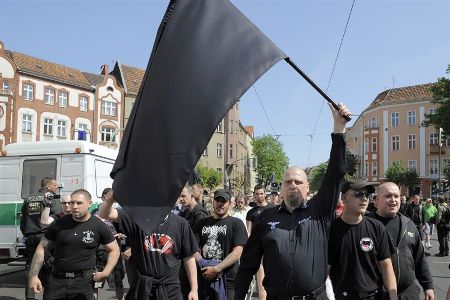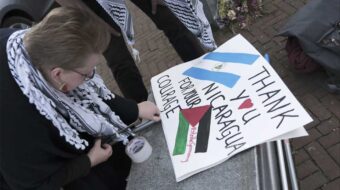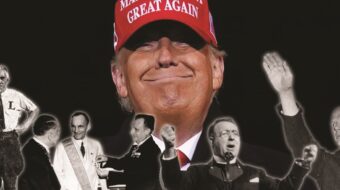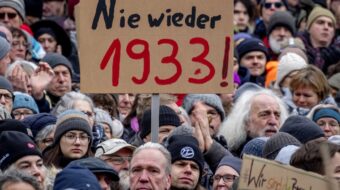
BERLIN — Close to my home here, I saw a frightening march Oct. 11 of Nazis, calling themselves the Nationale Sozialistische Partei Deutschlands, leaving out only the word “arbeiter” (worker) from the name Hitler used. Several thousand of them, almost all in black, many skinheads but also many all too “normal-looking” youngsters (and a smattering of very blonde girls), with the loudest loudspeaker I’ve heard in years blaring out their propaganda. They were agitating against democracy, denouncing the Bundestag representatives, even the cops, spreading hatred against all foreigners, but above all against the left and the leftists. At least one big banner contained a threat: “Make sure you know where the nearest antifascist club is located.”
They started at Alexander-Platz, halted at the circle near my house to yell and chant for 20 minutes, then marched along to Platz der Vereinten Nationen (UN Square, once Lenin-Platz) and along Landsberger Allee, once Lenin-Allee, stopping for a meeting, perhaps by accident halfway between where the big Lenin statue was torn down after the end of the German Democratic Republic (GDR) and the quiet, hardly noticeable little memorial cemetery with graves and a monument to those who died in the Revolutions of 1848 and 1918-1919.
After a ranting speech in tones recalling Hitler or Goebbels, too loud for me to understand much, their leader read out 50 or more names of all their “martyrs,” punctuating each name with a roll on a drum and his loud call for “rache” (revenge).
The only name I recognized was the big Nazi “hero” Horst Wessel, who died 200 meters from here in the hospital which the Nazis renamed after him until 1945. The song about his alleged murder served the Nazis as a main hymn and then as a second national anthem.
Along the main route from which began at the central Alexander-Platz there were hundreds of people walking along on both sides, shouting “Nazis raus” (Out with the Nazis”), often carrying handmade signs or some banners, including a few from the Left Party, the Young Greens, the new anti-establishment “Pirate Party” (which opposes laws limiting pirating of music) and a few from union youth and antifascist groups. Between the marchers and the protesters was a giant number of police, which walked along to protect the Nazis, or to keep the two groups apart. Scores of police vehicles, including a water cannon and an ambulance, were ahead of, next to or behind the marchers.
One man who was standing next to me watching the meeting noted that the anti-Nazis, mostly the same age as the Nazis, were also often wearing black jackets, the color in fashion these days, I guess. He seemed to lump both Nazis and anti-Nazis together, a worrisome development. I don’t know how many others also thought that way.
Most of the crowd was decidedly antifascist. Some, perhaps those whose emotions led them to break though to attack the Nazis, got arrested.
Especially frightening for me: many Nazis were carrying big flags, totally black except, in white letters, the county or town they came from. These represented the “fighting groups.” While some of those organized in the three officially permitted neo-Nazi parties are well-dressed and often clever tacticians (who profit from the fact that their legal parties still get state subsidies granted every party with a certain percentage of the vote), these hitherto semi-clandestine “fighting groups” are loosely allied with them, and are largely made up of the worst thugs, who go around beating up people of foreign background or of color and left-wingers, whom they call “zechen” or ticks. Even the most violent ones are rarely caught or arrested and, when they are, are usually dealt with very mildly. They gather in a number of bars and “youth centers” and purchase clothing with Nazi code-signs and paraphernalia at a number of shops in Berlin and most major cities. Some jackets have SS runes or the number 88, for Heil Hitler – H being the 8th letter of the alphabet.
They were especially excited because a few days ago two Molotov cocktails were thrown into one of their best-known bars and meeting places (aptly called “At the Executioner”), injuring a few of them, one severely. They immediately blamed this on leftist opponents of the bar, but the police are now convinced the bombs were thrown by disgruntled neo-Nazis, either because of turf quarrels or simply because the doorkeepers didn’t let them in some evening.
The march, the number of pro-Nazi young people, the blaring noise and the clear dedication to a fearful past made for a frightening event stirring up countless recollections here in the middle of Berlin.
The media are currently overflowing with recollections of those heroic weeks 20 years ago and of how the oppressed people of East Germany chose freedom and forced the fall of the Berlin Wall. It is the usual blatant over-simplification of a fearfully complicated matter, told in a completely one-sided way. Somehow I could not help recalling how we in the GDR scoffed or laughed when the party officialdom rejected the word “mauer,” or “wall” used almost universally for the Berlin Wall, and insisted, quite in vain, on the unwieldy term “antifascist protective barrier.”
Of course, everyone knew that it was erected to keep people in, not out, which was why so many rejoiced at its fall. But watching this menacing parade made me wonder: was it perhaps, in a way and in the historical long run, also indeed a kind of protection against Nazis like these?
But even considering such matters these days, at least aloud, is of course pure heresy.

MOST POPULAR TODAY

High Court essentially bans demonstrations, freedom of assembly in Deep South

Zionist organizations leading campaign to stop ceasefire resolutions in D.C. area

U.S. imperialism’s ‘ironclad’ support for Israel increases fascist danger at home

UN warns that Israel is still blocking humanitarian aid to Gaza






Comments